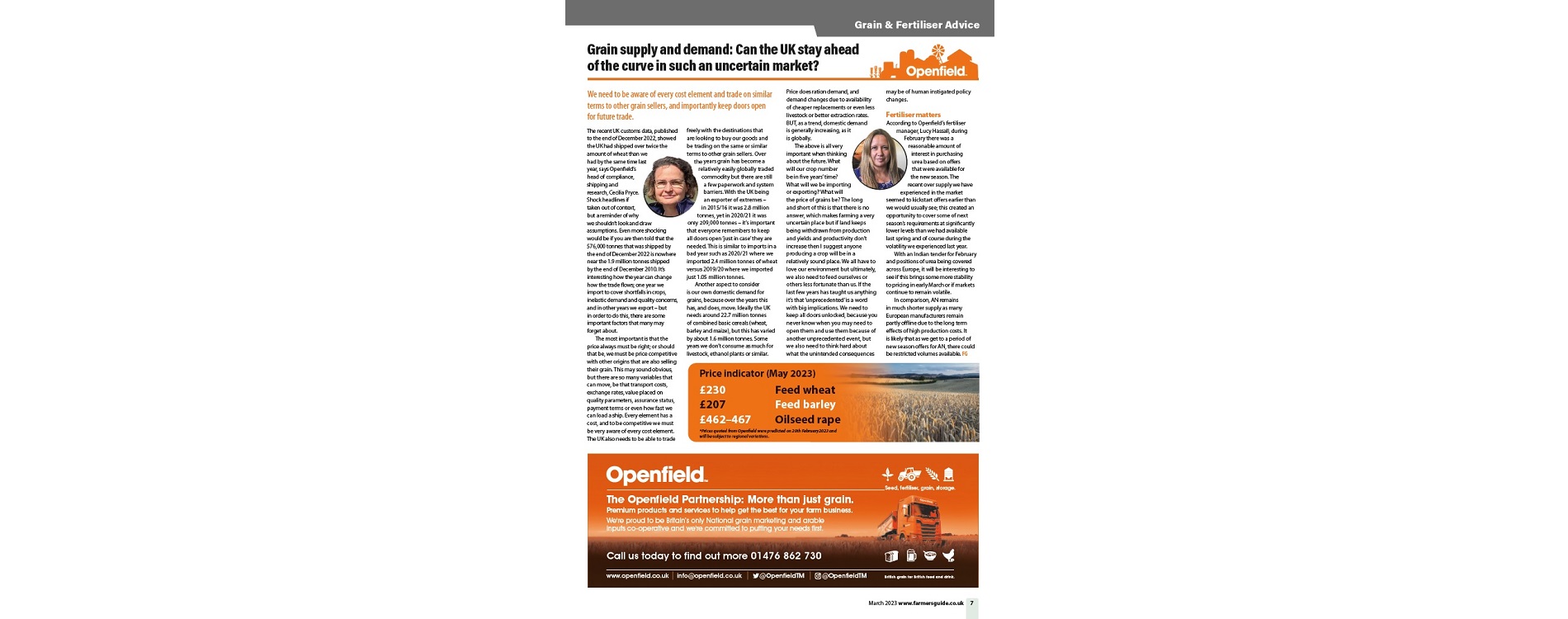Grain supply and demand: Can the UK stay ahead of the curve in such an uncertain market?
We need to be aware of every cost element and trade on similar terms to other grain sellers, and importantly keep doors open for future trade.
The recent UK customs data, published to the end of December 2022, showed the UK had shipped over twice the amount of wheat than we had by the same time last year. Shock headlines if
taken out of context, but a reminder of why we shouldn’t look and draw assumptions. Even more shocking would be if you are then told that the 576,000 tonnes that was shipped by the end of December 2022 is nowhere near the 1.9 million tonnes shipped by the end of December 2010. It’s interesting how the year can change how the trade flows; one year we import to cover shortfalls in crops, inelastic demand and quality concerns, and in other years we export – but in order to do this, there are some important factors that many may forget about.
The most important is that the price always must be right; or should that be, we must be price competitive with other origins that are also selling their grain. This may sound obvious,
but there are so many variables that can move, be that transport costs, exchange rates, value placed on quality parameters, assurance status, payment terms or even how fast we can load a ship. Every element has a cost, and to be competitive we must be very aware of every cost element. The UK also needs to be able to trade freely with the destinations that are looking to buy our goods and be trading on the same or similar terms to other grain sellers. Over the years grain has become a relatively easily globally traded commodity but there are still a few paperwork and system barriers. With the UK being an exporter of extremes – in 2015/16 it was 2.8 million tonnes, yet in 2020/21 it was only 209,000 tonnes – it’s important that everyone remembers to keep all doors open ‘just in case’ they are needed. This is similar to imports in a bad year such as 2020/21 where we imported 2.4 million tonnes of wheat versus 2019/20 where we imported just 1.05 million tonnes. Another aspect to consider is our own domestic demand for grains, because over the years this has, and does, move. Ideally the UK needs around 22.7 million tonnes of combined basic cereals (wheat, barley and maize), but this has varied by about 1.6 million tonnes. Some years we don’t consume as much for livestock, ethanol plants or similar. Price does ration demand, and demand changes due to availability of cheaper replacements or even less livestock or better extraction rates. BUT, as a trend, domestic demand is generally increasing, as it is globally. The above is all very important when thinking about the future. What will our crop number be in a few years’ time?
What will we be importing or exporting? What will the price of grains be? The long and short of this is that there is no answer, which makes farming a very uncertain place but if land keeps being withdrawn from production and yields and productivity don’t increase then I suggest anyone producing a crop will be in a relatively sound place. We all have to love our environment but ultimately, we also need to feed ourselves or others less fortunate than us. If the last few years has taught us anything it’s that ‘unprecedented’ is a word with big implications. We need to keep all doors unlocked, because you never know when you may need to open them and use them because of another unprecedented event, but we also need to think hard about what the unintended consequences may be of human instigated policy changes.
Fertiliser matters
During February there was a reasonable amount of interest in purchasing urea based on offers that were available for the new season. The recent over supply we have experienced in the market
seemed to kickstart offers earlier than we would usually see; this created an opportunity to cover some of next season’s requirements at significantly lower levels than we had available
last spring and of course during the volatility we experienced last year.
With an Indian tender for February and positions of urea being covered across Europe, it will be interesting to see if this brings some more stability to pricing in early March or if markets continue to remain volatile. In comparison, AN remains in much shorter supply as many European manufacturers remain partly offine due to the long term effects of high production costs. It is likely that as we get to a period of new season offers for AN, there could be restricted volumes available




